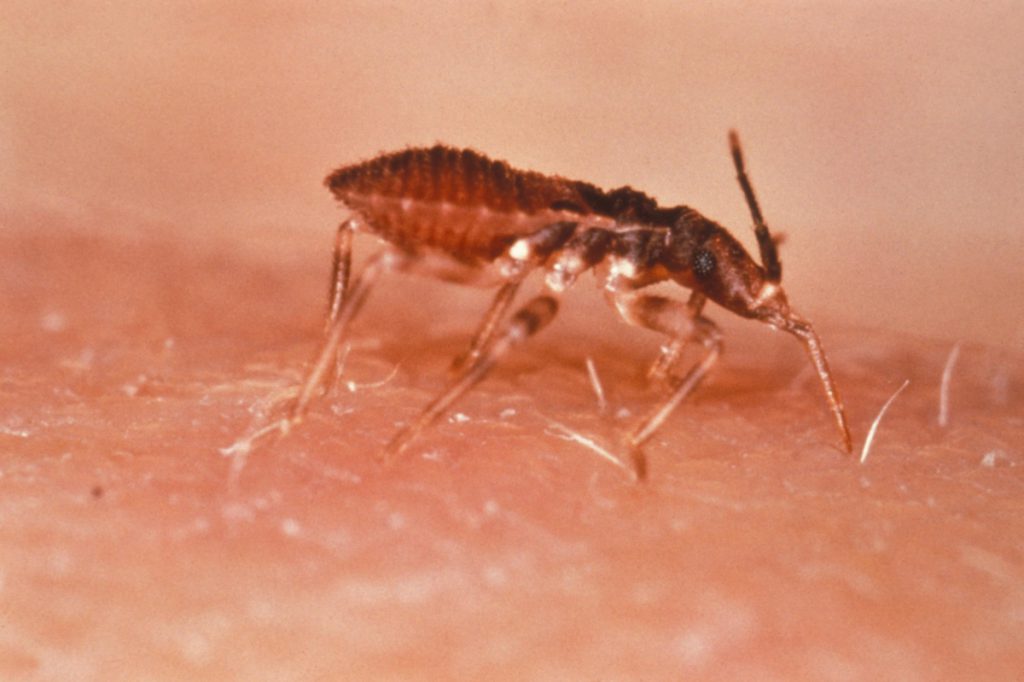SERVICE REQUEST?
Fill out the form below.
Find our nearest location
Your Local Office

Kissing Bug
Attribution:Content Providers(s): CDC/World Health Organization, via Wikimedia Commons
Size:
About one inch in length.
Color:
Varies from brown to dark gray.
Behavior:
Kissing bugs are members of the genus Triatoma and belong to the insect Family Reduviidae known as “assassin bugs” because they are predators that capture and eat insects and possibly small reptiles. However, members of the genus Triatoma are the exception in the family because they feed on the blood of mammals, birds and other vertebrates. They are called kissing bugs because the species that is most often associated with human exposure may often feed around the human lips and facial areas. The bite of kissing bugs is essentially painless, and the victim rarely awakens during the feeding period which can last 15 minutes or longer. The bugs will feed on any exposed portion of the body, but bites normally occur around the face, including around the eyes. These insects are most common in Central and South America and are the principal carriers of the trypanosome organism, Trypanosoma cruzi, which causes Chagas disease. This disease is endemic in many regions of Central and South America but is relatively unknown in the United States. The disease organism is transmitted through the feces of the kissing bug. Many kissing bug species defecate as they feed, and the victim often scratches the area providing openings for the infected feces to pass through the skin. Fecal matter may also be rubbed into eyes and ingested through the mouth. Other Triatoma species, however, wait until after feeding to defecate when they are away from the host. The potential for disease transmission by these species is therefore minimal. Again, it is important to point out that kissing bugs in the United States are not known to transmit the Chagas disease organism, although some species may be carriers of the trypanosome. Recent cases of Chagas disease in the United States have been the result of people traveling to Central or South America and encountering infected kissing bugs in those countries.
Of the 12 species of kissing bugs known in the mainland United States, only a few are considered “peridomestic,” meaning they may live in or near buildings. Most species are sylvantic, living in wooded areas far from human habitation. They live close to their hosts, which are usually wild rodents in the U.S., and may also feed on raccoons, possums and even cats and dogs. Pack (wood) rat burrows are common homes to these blood-feeding insects. Around homes, kissing bugs will be found wherever rodents are found living – piles of lumber, bricks and firewood, or in sheds, under decks, in barns, and even in dog houses. Attics and crawlspaces may also provide harborage for these insects. Inside buildings, they rest during the day, hiding under and behind furniture and similar dark areas before seeking out a person to feed upon when the room is dark. They are strong fliers and are attracted to bright lights on buildings. Most often, the homes that experience kissing bug invasions are those located in secluded areas, usually wooded lots.
Should kissing bugs be found inside a home, the services of an experienced professional should be strongly considered. Terminix recommends the following tips:
- Control rodents to limit the kissing bug’s host.
- Remove potential harborage from the property
- Keep exterior lighting off or switch to yellow “bug light” bulbs to possibly reduce the numbers of bugs attracted to the home or building.
- Seal exterior cracks and holes in the walls.
- Use tight-fitting insect and rodent screening in attics and foundation vents.
- Install fitted, screened caps in chimneys to reduce animal access.
- Remove any raccoons, rodents or other animals from attics or substructures.
- Use sticky insect traps to capture bugs and reduce the population.
- Hire a professional to treat all possible voids and cracks where kissing bugs may harbor.
Family Name:
Triatoma spp
Read What Our Clients
Are Saying
My Terminix tech Scott is the best! He is professional, courteous and absolutely thorough about his job. Thank you for sending such a blessed tech to my house. Hamlet, NC
This letter is to say how pleased we are here at Morreene West Apartments with your services. We are very pleased with the technician, Christopher. He does a great job. Durham, NC
Terminix has consistently offered our apartment complex reliable, competent service. We are completely satisfied with their knowledgeable representative who is always punctual and does a superior job for us every time. Chapel Hill, NC
I would like to take the time to thank you for giving us such great service here at Carver Pond Apartments. Your Pest Technician Christopher Mitchell has provided us with excellent service over the last few months. Christopher is such a great help to us in providing helpful information so that we can better serve our residents here at Carver Pond. Durham, NC
SERVICE REQUEST?
Fill out the form below.